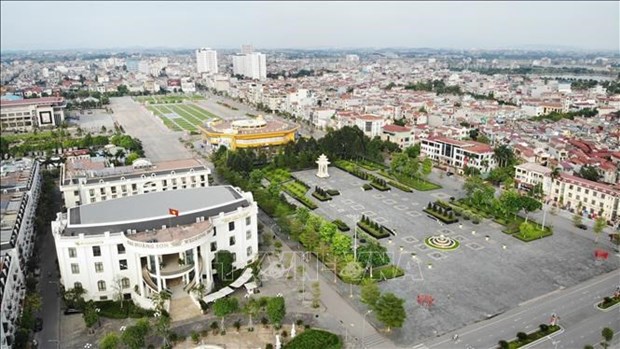
Bac Giang city in the northern province of the same name is mobilizing all resources to effectively implement its development plan for the 2021-2030 period. The plan focuses on turning the city into a green and smart urban area, according to the Chairman of the municipal People’s Committee Dang Dinh Hoan.
The city will strive to fulfill criteria for the first-tier urban area in the period, he said.
It will focus on attracting investors with financial potential and experience to carry out large-scale projects and high-rise buildings, as well as coordinate with the construction sector to devise specific mechanisms for the city’s development.
Attention will be paid to the deployment of four key transport infrastructure projects in the locality. They include a project on expanding Provincial Road 293 with a total estimated investment of 300 billion VND (12.2 million USD) and a belt road from Tran Hung Dao Street to National Road 31 with an estimated capital of 900 billion VND.
By the end of September this year, the city has completed detailed planning for urban area No. 15; the mixed urban area and Bac Giang international market; Dinh Tri-Tan Dinh and Dong Son-Tien Phong urban areas, raising its detailed planning to about 80%.
Bac Giang has implemented the first phase of a project to improve the landscape on both sides of the Thuong River. It has set up a lighting system, installed flower arrangements, and repaved the sidewalks, the official said.
The city also devised a planning scheme for its central area and poured investment into the development of common spaces and social facilities such as a park system, green trees, and cultural, sports, and entertainment halls.
It has focused on upgrading technical and social infrastructure, particularly in the areas of transport, electricity, water supply and drainage, and the environment. The city will work to put power lines underground as well as improve the drainage system.
The city has so far installed 33 security surveillance cameras and traffic lights, replacing lighting systems on 122 routes and setting free Wifi hotspots, Hoan said.
Currently, Bac Giang is building a geographic information system (GIS) and an Intelligent Operation Centre (IOC) to ensure effective urban planning and management.
The city, spanning 66.77 sq.m, has 16 administrative units at the communal level. It is the political, economic, and cultural hub of Bac Giang province.
Situated on an artery road linking Hanoi with Lang Son, and the Huu Nghi international border gate, the city has a favorable location on an economic corridor running through the four localities of Lang Son, Hanoi, Hai Phong, and Quang Ninh.
Under the Bac Giang Development Master Plan for 2021-2030, with a vision to 2050, which has been approved by the Government, the province will become a modern industrial locality with Gross Regional Domestic Product (GRDP) ranking among the top 15 in the nation by 2030.
Bac Giang's average economic growth in the 2021-2030 period is expected to reach 15-16%, with industry construction expanding by 17-18% per year.
By 2030, the industrial-construction sector will account for 66-67% of the locality's economic structure while the service, agriculture-forestry-aquaculture, and taxes on goods and services will make up 24-25%, 6-7%, and 2-3%, respectively.
The GRDP per capita is expected to increase to 9,800 USD by 2030. Bac Giang enjoyed an annual average GRDP growth rate of 13.9 % in the 2016-2020 period, making it one of the best performers in the country.
Particularly in 2021, its GRDP expanded by 7.82% compared to the national average rate of 3.78 percent, ranking 10th in the country while the GRDP per capita rose 3.7% to 2,950 USD.
By the end of 2021, the locality was home to over 1,800 valid investment projects, including nearly 500 FDI projects valued at 6.9 billion USD.
Source: Vietnam Plus

